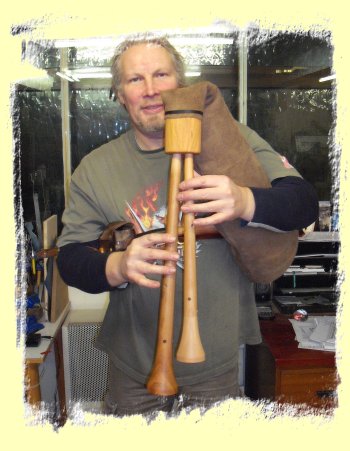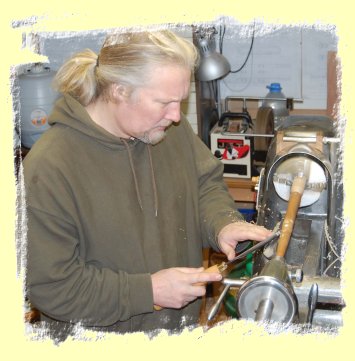
Myal Pyper, Hys Pipes
The Double Chanter Bagpipe in England (An Ongoing Story)
(Chanter - the bit that the fingers play to produce the tune)
(Double Chanter - each hand plays an individual pipe allowing the addition of a harmonic second line and thus a fuller sound.)
Depictions of Double Chanter pipes, carved
in stone and wood, are found in various churches
right across England and date from the mid 14th to
16th centuries. This is not to say they are any more
“English” than the single chanter pipes also known from
the period, indeed the bagpipe is one of the few
instruments that has become a national and/or regional icon,
the discussion of which would fill more pages than this humble
website has.
As with single chanter pipes there is no exact form (that seems
to be a later development) but all have two separate pipes played by
separate hands and most, though definitely not all, also have a single drone in
the top of the bag similar in layout to its more famous cousin, the Great Highland
Bagpipe (or Scottish bagpipes or even just bagpipes to most!)
Sadly, apart from the carvings, that is all we know at present about these bagpipes. So
when I came across “Zampogna” several years ago in France that re-kindled an
interest that has stayed foremost with me ever
since.
The plan was; by getting to grips with Zampogna I would have a
better idea how to create a set of my own pipes with more of (dare I
say) an
“English” look and musical character about them. However
this is not to say that Zampogna were far removed from what I needed to
fulfil that aim. They have, as an instrument, survived in southern
Italy relatively unchanged (if the artwork is anything to go by) since
at least the 16th century. Perhaps one of the few
differences with what they are and what I needed was that they have both chanters
playing almost the same run of notes (G-D & F#-D) but an octave apart
thus making them work towards producing a simple melody backed by a
simple bass line, whereas the depictions we have of Double Chanter pipes in England
suggest a single octave split in the middle between the two hands with
some
notes overlapping in the middle between those two hands.
A set of Zampogna were made for me by Marco Cianciaruso, Chiasso, Switzerland in 2006 and then in 2009 I made my first version of what has become a great musical discovery (well, at least for me - should get out more really!) These are, in fact, the pipes you are, I hope, listening to at present and what you see below. It then took me several more years to get round to creating my second set as our "Great Project" took over! In 2015 I made another set of double chanter pipes this time using single reeds on each chanter as opposed to the set you see below which uses double. (Reeds being what produces the sound, single as in the sound of say, a clarinet as opposed to double, for instance, an oboe).


However, before the great love affair with Double Chanter pipes I played the more "normal" kind, ie. two hands playing upon one stick.
The single chanter sets I owned were both made by Sean Jones (see links page). The smaller of the two, called “small pipes” or “Dudey”, using a tonic in D, has a straight bored chanter and a relatively large double reed producing a softer sound. This system went onto develop into the Northumbrian bagpipe.
The second Jones set (pictured right), larger in general, has a conical bore chanter with a smaller, harder double reed producing a more shrill sound. These are in G and known today as “Border Pipes” though similar instruments had been in existence widely throughout Europe since the 16th century.

For those bemused by why I never appear to blow the instrument with my own lungs; there are two systems of getting air into the bag. The first, and definitely the older, is mouth blown, the second uses a set of bellows strapped under the arm not controlling the bag and is sometimes called the “cold wind” system. The advantage of using bellows is the lack of moisture (present when using the mouth), moisture that can play havoc with the reeds and even effect the wood of the instrument itself. Bellows were in use as early as the 1500s and it is the principle method I use as it allows a more stable instrument.
